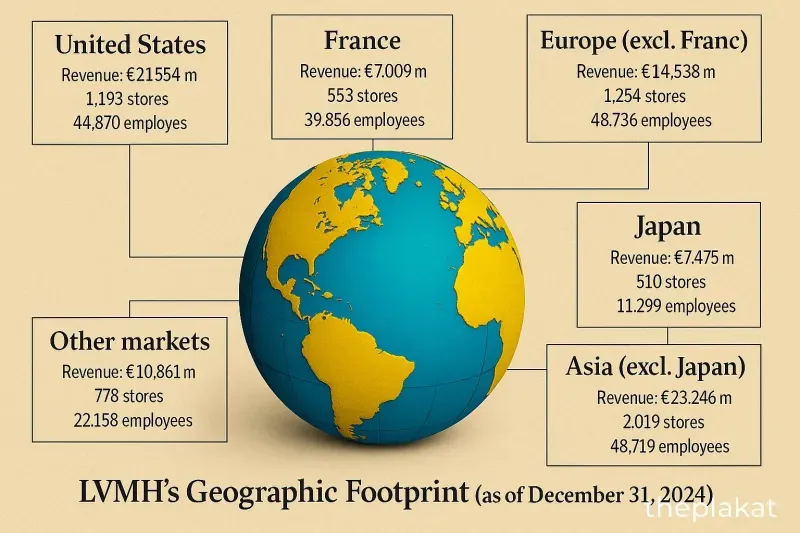Published
in Business
The geographic footprint of LVMH in 2024 reveals a powerhouse of luxury rooted across continents. With Asia leading in revenue and Europe maintaining a stronghold in employment and store presence, LVMH’s distribution strategy reflects global balance and localized strength.
Asia (excluding Japan) leads the world in revenue for LVMH with €23.25 billion, over 2,000 stores, and nearly 49,000 employees. Japan alone contributes another €7.48 billion through its 510 stores. The dominance of Asia illustrates the region’s appetite for luxury goods like leather goods, perfumes, wines, and cosmetics—products often favored as status symbols and lifestyle markers in fast-growing economies.
The United States stands as LVMH’s second-largest revenue market, generating €21.55 billion through 1,193 stores and employing 44,870 people. American consumers consistently drive high demand for fashion and leather goods, especially brands like Louis Vuitton and Dior. The retail presence is extensive, reflecting the country's vast geography and diverse consumer base.
Combined, France and the rest of Europe account for €21.55 billion in revenue, nearly equal to the U.S. France, LVMH’s birthplace, employs nearly 40,000 across 553 stores, while the rest of Europe houses 1,254 stores and 48,736 employees. Europe's dense store network supports tourism-driven retail, particularly in historic cities known for luxury shopping.
Markets grouped under 'Other' represent €10.86 billion in revenue with 778 stores and over 22,000 employees—each region contributing less than 1% individually. While these may seem minor, collectively they highlight diversification into high-potential areas such as the Middle East and Latin America, offering new growth vectors and opportunities for experimentation.

The 'Other markets' segment includes countries and regions not specified individually, such as Latin America, Africa, Oceania, and the Middle East. Each contributes less than 1% to the total but collectively generate significant revenue.
Asia (excluding Japan) leads with 2,019 stores, reflecting both consumer demand and market penetration across multiple countries.
Japan's luxury market is driven by high per-store performance and premium pricing, allowing it to generate significant revenue with a relatively lean workforce.
Key drivers include cosmetics, perfumes, fashion, leather goods, and wines. These products are often considered status symbols and are highly sought after in growing Asian economies.